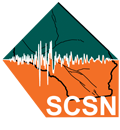Significant Events
- Largest event: M4.9, 30 Sep 2020 17:31:27 PDT, (33.057, -115.590), depth 11.5km. 4km NE of Westmorland, California
- As of 01 Oct 2020, 05:54AM PDT, the following events have been recorded in the swarm:
- M≥4: 6
- M≥3: 54
- M≥2: 270
- Other M4 events recorded:
- Ml 4.0 Oct 1, 2020 03:37:04UTC 33.052, -115.575 ci37456405
- Mw 4.5 Oct 1, 2020 03:36:34UTC 33.068, -115.597 ci39643328
- Mw 4.1 Oct 1, 2020 01:10:25UTC 33.049, -115.592 ci39641880
- Mw 4.1 Oct 1, 2020 00:58:13UTC 33.065, -115.593 ci39641768
- Mw 4.2 Oct 1, 2020 00:41:18UTC 33.073, -115.601 ci39641616
Swarm Numbers
- There were 96 events during the 3 days prior to the M4.9 (within a 10 km radius). As of 01 Oct 2020, 01:37PM PDT, there have been 632 events recorded after the M4.9.
- The SCSN has so far recorded over 700 events in the swarm, the smallest M1.1. Many of the smaller events are still being analyzed and will be gradually added to the catalogue.
- More activity is expected in the next few days. There is a small chance (about 5%) that a larger quake could occur, with the likelihood decreasing over time.
Historical Seismicity
- Since our records began in 1932 we’ve had 112 events of M4 or greater within 10km of today’s event.
- The largest historic event was M6.2 on 1987/11/24.
- The most recent historic event was M4.3 on 30 Sep 2020.
- Similar swarms in this area have been recorded in 1981 and 2012 with similar/same sense of motion and maximum magnitudes within the M5 range. For more informtation about the 2012 swarm visit M5.5 Brawley Swarm.
Faults
- CFM fault associations: most likely Westmorland fault; splay segment (94%). Alternates: Not associated with a CFM modeled fault (4%), Other CFM faults (2%).*
- Nearby faults: Imperial fault (13.8 km).**
Additional Information
- Links for: USGS earthquake page, ShakeMap, DYFI, waveforms.
- Visit our special reports page for further information on local notable earthquakes.
- Visit our SoCal swarms page for general information on local swarm monitoring.
Below are the waveform data associated with this event, as recorded in our Live Seismograms Feed. Note that a M2.7 event is visible for the first 36 seconds before the M4.9 is detected. More videos of the swarm will be available soon.
*Earthquakes can occur both near or on major known faults, and in places where no clear fault zones are known. Using the statistical method of Evans et al. (in prep. 2019) the location and focal mechanism of this earthquake suggest the above association with modeled faults in the Community Fault Model (CFM) provided by the Southern California Earthquake Center (SCEC) and Harvard University. Note that the CFM fault association may be different from the nearby faults list. Differences may arise due to different fault databases, and because the CFM fault association uses the hypocenter with relation to subsurface 3-dimensional fault orientation models, while the nearby faults list utilizes mapped surface traces as they relate to the epicenter.
CFM Fault: SCEC CFM 5.0 Fault name and closest segment if available; The CFM is maintained by Harvard University, Dept of Earth & Planetary Sciences.
Probability: The probability in percent the earthquake is associated with this fault.
SCSN: Caltech/USGS Southern California Seismic Network
**U.S. Geological Survey and California Geological Survey, 2006, Quaternary fault and fold database for the United States, accessed 2015, from USGS web site: https://earthquake.usgs.gov/hazards/qfaults/
This information is subject to change as more up-to-date data become available.






